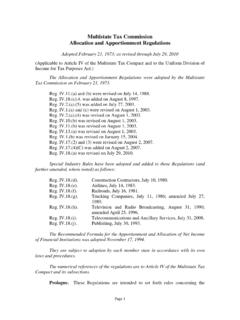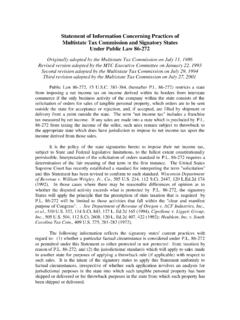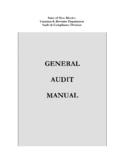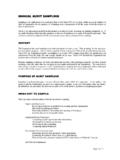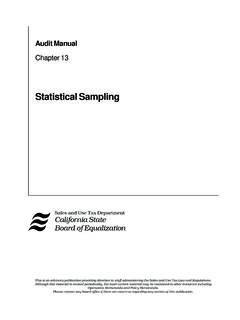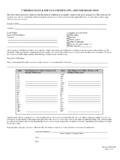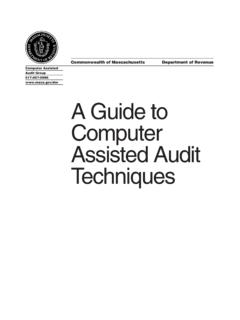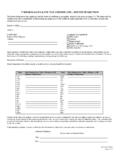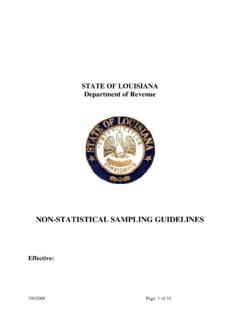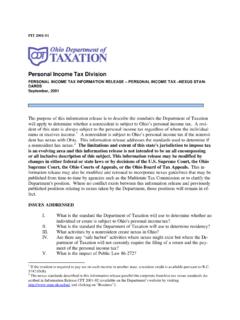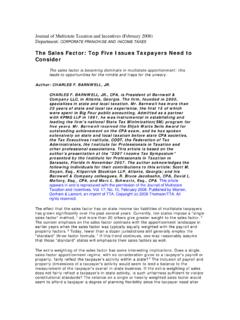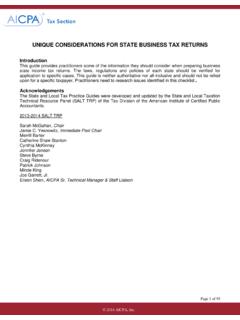Transcription of Income & Franchise Tax Audit Manual - mtc.gov
1 Income & Franchise Tax Audit Manual Rev. March 2013 multistate Tax commission 444 North Capitol Street, , Suite 425 Washington, 20001 Telephone: 202-650-0300 Website: MTC Income & Franchise Tax Manual March 2013 Page 2 of 100 [This page intentionally left blank] MTC Income & Franchise Tax Manual March 2013 Page 3 of 100 multistate Tax commission Income & Franchise Tax Audit Manual Table of Contents Chapter Title Page ..4 and Procedures ..8 of Limitation & Waivers ..10 with ..16 Investigation ..24 of Income ..43 Adjustments ..52 & Non-Business Income .
2 60 ..71 Income & Deductions ..86 Operating Losses ..87 of Proposed Tax Changes ..90 ..91 of Audit Report ..96 & Transmittal to Participating States ..98 MTC Income & Franchise Tax Manual March 2013 Page 4 of 100 1. Introduction The Joint Audit Program of the multistate Tax commission ( MTC or commission ) was initiated in the early 1970s under the auspices of Article VIII of the multistate Tax Compact. This Income & Franchise Tax Audit Manual ( IFTAM or Manual ) sets forth the procedures that commission auditors follow in performing a joint Audit on behalf of the Joint Audit Program member states who have elected to participate in a specific Audit .
3 The information provided in the MTC IFTAM does not reflect changes in law, regulations, notices, decisions, or administrative procedures that may have been adopted by Joint Audit Program member states since the Manual was last updated. The IFTAM is provided for the guidance of the commission s joint Audit staff and is not authoritative, and may neither be cited to support an Audit position nor relied upon by a taxpayer. The laws of the states for which a joint Audit is being conducted govern Audit positions with respect each state. The Manual merely reflects the commission s internal joint Audit procedures and guidelines.
4 Any suggestions or corrections are welcomed and should be communicated to commission s Joint Audit Program director. MTC Income & Franchise Tax Manual March 2013 Page 5 of 100 2. Terms and Definitions This section lists terms and definitions use extensively in multistate audits; in many cases, the terms are statutorily defined by the states, and there may be differences among the states in how a particular term is defined. Auditors will need to develop a general, working knowledge of these terms and definitions. Allocation. A method of sourcing taxable Income to a state or other political subdivision.
5 Nonbusiness Income is allocated to a state if it can be specifically sourced to that state. For state tax purposes, nonbusiness Income is usually allocated to the state of the corporation's commercial domicile, or to where the property giving rise to the Income is located. Apportionment. A method of attributing Income to the states in which a multistate or multinational corporation is doing business. A portion of the corporation's Income is divided (based on an apportionment formula) among the taxing states. Apportionment Formula. The manner of computing the portion of a taxpayer s Income subject to tax in a particular state.
6 The standard Uniform Distribution of Income for Tax Purposes Act (UDITPA) formula is the average of three factors multiplied by the taxpayer's business Income . The three factors are: property, payroll and sales. Variations of this formula are also used in various states. Business Activity. Business activity refers to transactions and activity occurring in the regular course of a particular trade or business of a taxpayer. Business Income . Generally, this is Income which arises from the regular course of a taxpayer's trade or business. It includes Income from tangible and intangible property, if such property constitutes an integral part of the taxpayer's regular trade or business.
7 Combined Reporting. A method of measuring the tax liability of a corporation. An apportionment formula is applied to the combined unitary Income of the corporation and its affiliates. Combined Report. A combined report is a report in which the business Income and apportionment factors of a unitary group of corporations are combined for purposes of determining each taxpayer s share of the unitary business Income . Commercial Domicile. The principal place from which the trade or business of the taxpayer is directed or managed. Compensation. Wages, salaries, commissions and any other form of remuneration paid to employees for personal services.
8 MTC Income & Franchise Tax Manual March 2013 Page 6 of 100 . Consolidated Returns. Under federal law, a filing method which allows certain related corporations (over 80 percent ownership) the convenience of filing a single tax return and paying one tax amount Fiscalization. The process of placing the Income and formula factors of unitary corporations with differing accounting periods onto a common taxable year-end in order to compute a combined report. Foreign Corporation. For state purposes, a corporation which is organized under the laws of another state.
9 For federal purposes, a corporation organized in a foreign country. Intrastate Apportionment. The process of determining the unitary Income apportioned and allocated to each taxpayer in a combined group. This process is necessary in order to determine the individual tax liability for each taxpayer, as well as to properly compute items such as NOLs, AMT, and tax credits. Nexus. A connection or link between a corporation and a state, which is sufficient to empower the state to tax the corporation's Income . Non-business Income . Generally, nonbusiness Income is all Income which is not business Income ( , the Income doesn't arise from the taxpayer's normal business activities).
10 PL 86-272. Public Law 86-272 (15 USCA 381) was enacted in 1959 to limit the states' ability to tax interstate commerce. It provides that a state cannot impose a net Income tax on a business if the business activities within the state are limited to the solicitation of sales of tangible personal property. Sales. All gross receipts of the taxpayer not allocated as nonbusiness Income . State. Any State of the United States, the District of Columbia, the Commonwealth of Puerto Rico, any Territory or Possession of the United States, and any foreign country or political subdivision thereof.
